Mobility For Athletes: More Important Than Ever
Speed & Agility | Sports PerformanceABOUT THE AUTHOR

Dr. Chris Holder
Chris Holder comes to the TrainHeroic Blog with over thirty years as an athlete and coach. Chris is the Head Strength and Conditioning Coach at Cal Poly San Luis Obispo in California. A football player first and then spending his entire professional coaching career at the college level, Holder has been in love with everything weight lifting since he was a little boy.
One of the hottest movements in the fitness/strength world right now is the mobility craze.
I won’t call it a fad for one “pink elephant” reason: we as a species are currently devolving. We all move like crap and with the advances in technology and our incessant need to sit, the human form is beginning to change. Unlike the old days where our grandfathers and great grandfathers’ bodies began to lose function because of a lifetime of physical labor, many of our kids and young adults are beginning to show similar signs of breakdown – but for the opposite reason.
How many of you have ever had a significant injury? One that required a time where a joint, or joints, needed immobilization?
Remember when the cast or brace was removed that first time? For those of you who haven’t experienced this, that limb, or ankle, or hand felt almost like it doesn’t belong to you.
Stiff, sore and weak are all familiar adjectives when starting over.
Why is this? Why is an ankle so tight, and almost frozen after wearing a walking boot for three weeks?
// The SAID Principle – Specific Adaptation to Imposed Demands
It all boils down to the SAID principle: Specific Adaptation to Imposed Demands.
The most general way to look at the SAID principle is, everything you do in your day – lift weights, sprint, sitting, walking, laying down – are stimulus for change in your body. The nervous system has countless jobs in the grand scheme of things, with keeping you alive being the highest priority. Therefore, your body is adapting to everything your day throws at it.
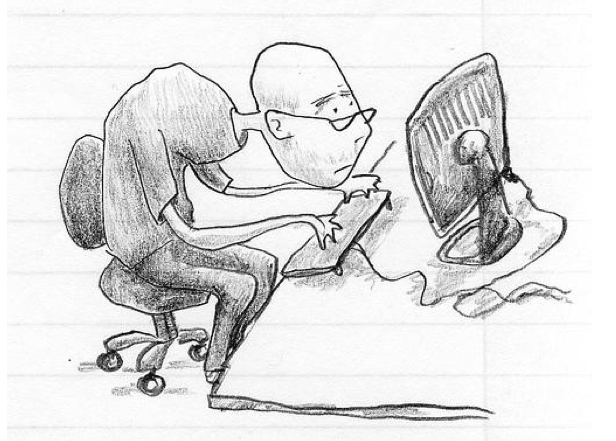
Unfortunately the vast majority of us are sending the signal of sitting on our asses. The hip flexors shorten and tighten, the glutes and hamstrings become deactivated, the shoulders round foward and many muscles lose complete function due to extended periods of time holding a static position.
Sitting in front of a computer at your work desk for 8 hours, every day for a career is a perfect example. Sound familiar?
The first time I saw this manifest into a “syndrome” was when I was in my senior year of college in the late 90s.
I was taking an advanced modality sports medicine course and had to give a presentation on something called Trendelenburg Gate. Never hearing of this before, I did copious amounts of research and was startled by what I found. Basically, those suffering from this develop an abnormal walking gate because the abductors of the hip (glute med and minimus) have become pathologically weak.
So much so they found that many of these people had lesions on the gluteal nerve rendering that sentenced them to a lifetime of hip and movement issues. And guess what causes this?
Sitting.
Bus drivers, secretaries, and people who have chosen a profession where they are forced to sit for extended periods of time were the majority of sufferers. I was startled that this was even a thing. Understand, though, this was almost 20 years ago.
Fast forward to today and many of these things like Trendelenburg Gate are the norm.
Heartbreakingly, it’s starting to manifest in our youth. I see issues stroll into my facility on a daily basis that leave me astonished.
How on earth is an 18 year old suffering from chronic low back pain?
When was it the norm where over 50% of athletes show up with absolutely zero arch in their foot?
How have these people made it far enough in athletics where they are on scholarship yet cannot raise their arms into full shoulder flexion?
// Mobility Is a MUST
Mobility for athletes is now mandatory, regardless of the sport.
Gone are the days where young athletes spend their summers outside only coming inside for food and water (and most of us drank from the green hoses attached to our houses- ahhhh, the good ole days). We coaches have to develop protocols to bring some of these muscle groups back online.
The following are some of my favorite drills for many of our hard to fix common problems we now see.
Mobility For Athletes: The Foot and Ankle
Like I said above, the arches of some of these kid’s feet are shocking and the mobility of their ankles is equally disturbing.
My thought process on priorities are this: The foot is the lone contact point with the ground, the place where ground forces and load impacts are introduced to the entire body.
The foot and ankle have to be functioning optimally for the athlete to reap any sound rewards from their training. If these issues are not addressed from the beginning, this person will develop issues up the chain that will inevitably sideline them at some point in their careers. Take care of the foot and ankle first.
Rolling the foot with golf balls
When I was studying kung fu we spent a long time working our feet with a golf ball. Our reasons were slightly different than that of the athletes I train, but one thing is certain: the value of rolling your feet out before training cannot go understated.
One to two minutes minutes per foot is adequate and the pressure you should apply needs to be in “oh my God, this is really uncomfortable” range. It can downright hurt if you are not careful. Yes you could use a softer object like a lacrosse ball or tennis ball, but then we would all have to call you a wimp. The releases you will get, the myofascial work, and the attention to the plantar fascia can only be duplicated by a professional body worker.
Many issues with the hip, knee and even as far away as the jaw have been linked to foot dysfunction… so roll out your feet with a golf ball before every workout.
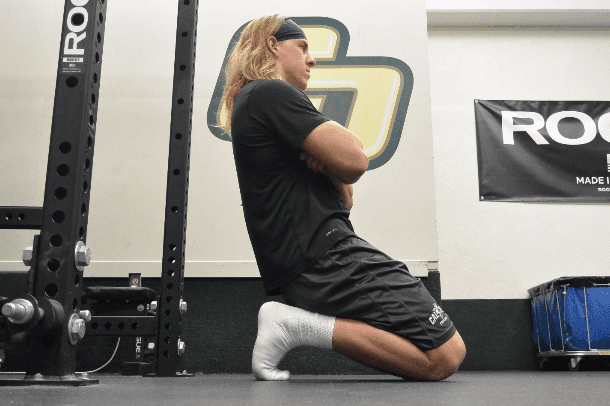
At Cal Poly we do 90 seconds of two ankle sitting drills before training.
The first is a knees together, feet together, toes curled under like a sprinter in the blocks exercise. Tuck the toes and then sit back on your heels to open the toes and open the plantar fascia.
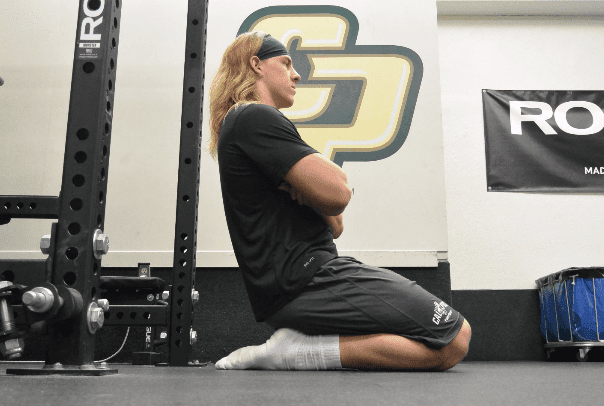
We then put the “laces down” and sit down on a hyper plantar flexed ankle.
This opens the cuneiform, cuboid and navicular joints of the top of the foot. These three joints have a direct neurological connection to the psoas, hamstrings and muscles of the hip. If you are bound up in any of these three areas, you can plan on having some type of muscular issue north of the foot.
Mobility For The Hip and Glutes
Here’s how I want you to look at this. I would say that nearly 9 out of 10 times, glute issues are a manifestation of something dreadfully wrong in someplace other than the glutes themselves.
So, if you think you have a glute problem, stop rolling out your butt and start looking for something in the neighborhood that is equally tight or weak. If your hip flexors are tight and restricted from sitting, you are shutting down the “potential” activation of the glute muscles.
Imagine your elbow is jacked up and you can only straighten it 2/3rds of its normal range of motion. Because you cannot reach full lock out, the triceps on that arm will never be able to contract fully making them underdeveloped and weak. If you can wrap your mind around that, then you have a picture that you can associate with your glutes. If your hip flexors are bound up, they act like a parking brake for your hip. If you can’t reach full hip extension, no matter how hard and heavy you train, your glutes will never reach maximal contraction, therefore, will never reach their full potential.
First off, get your damn feet out of the braces and don’t show up with tape on your ankles. You are making the problem infinitely worse.
Next, find ankle mobilizations you can perform to get the entire joint moving.
I could write an entire article alone on this very topic, so identify where you are missing range of motion and find drills to address it.
An easy way is to film yourself squatting. Do you “melt” to the inside of your foot as you descend? Can you keep your heel planted throughout the entire range of motion? Can you keep your big toe planted the whole time or do you roll out to the outsides of your foot? If you can’t keep your ankle stable during a squat, you are likely in need of some ankle mobs.
My two favorite places to find solid recommendations are on Dr. Tim Simansky’s The WODdoc and on Dr. Kelly Starrett’s MobilityWOD.
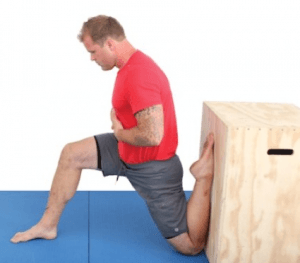
Psoas and hip flexor release
We have to get these muscles to relax and lengthen. Your glutes and low back depend on it. Because of our sitting society, I don’t care how you mobilize your hips, just do it. Pick any stretch or exercise to open the anterior of the hip. Quad stretches, hurdler stretches, lunges, you name it. Get the hip into extension and force the edges of the available range of motion.
We do a combination Cossack squat into a lunging sun salutation pose to start unlocking the hips before training. Back and forth, back and forth to force the hips into submission. We also use a psoas smash to release some of the more locked up psoas muscles. Check out any of those names online and you will find quality references for them.
One of the best hip flexor mob/glute strengthening exercises on this planet is the kettlebell swing. It’s an all in one stop that can truly change your life. If you are not swinging, you are not serious about correcting your hip issues.
Mobility For The Thoracic Spine
If the ankle is the gateway to the lower body, then the thoracic spine is the gateway to the upper body.
Anything that happens in an upper body movement starts at the thoracic spine. Unfortunately, for reasons that we have already covered, what should be a very mobile and dynamic joint area becomes locked up and restricted. This is bad for a myriad of reasons the most important being the thoracic spine is intended to move in a very fluid way. If you are locked up in the thoracic spine, you can expect an array of shoulder, upper and lower back issues to manifest.
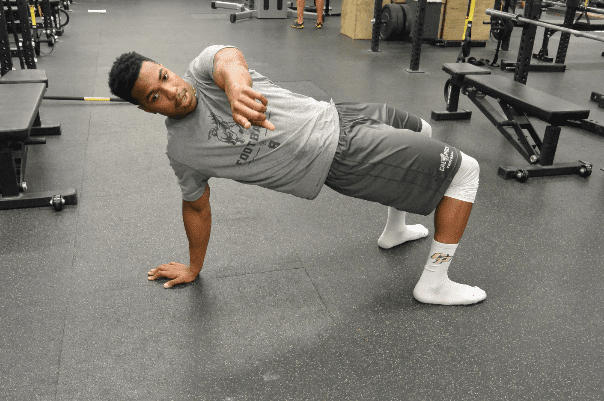
Thoracic Bridge
One of our go to’s at Cal Poly is the thoracic bridge. This is a primal movement pattern that incorporates full body integration to mobilize the T-spine. We love this because if forces our athletes to not only get the upper spine moving, but also makes them learn to stabilize the shoulders and hips as they move in one fluid motion.
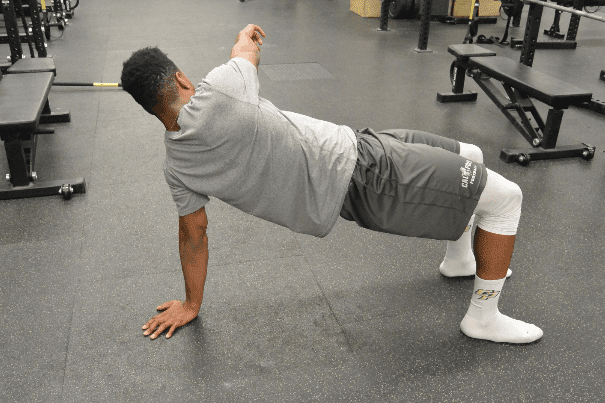
Anterior/posterior and lateral thoracic glides
These exercises introduce gross front to back and side to side thoracic movement that many of us have lost. Elementary in nature, we like these because if forces the athlete to really drop into what they are feeling and developing a proprioceptive relationship with their backs. Because we never see our backs, we tend to lose our connection with that which we cannot see. These drills start the movement and reintroduce us to our t-spine.
// Closing Thoughts
You’re athletes come to your program with years of sitting in desk. Their bodies are already beginning to break down and it’s your job to prevent that from happening. Add these mobility drills in on prior to training and you’re on the way to a team full of stellar athletes.
Are you a better coach after reading this?
More coaches and athletes than ever are reading the TrainHeroic blog, and it’s our mission to support them with useful training & coaching content. If you found this article useful, please take a momemnt to share it on social media, engage with the author, and link to this article on your own blog or any forums you post in.
Be Your Best,
TrainHeroic Content Team
HEROIC SOCIAL
HEROIC SOCIAL
TRAINING LAB
Access the latest articles, reviews, and case studies from the top strength and conditioning minds in the TH Training Lab

